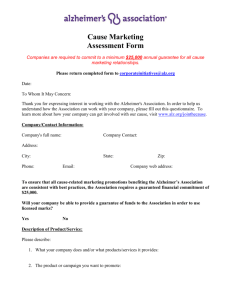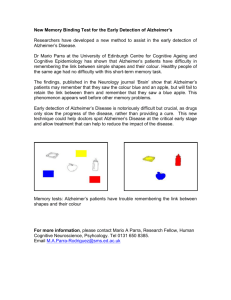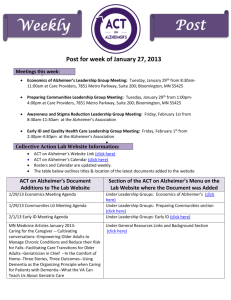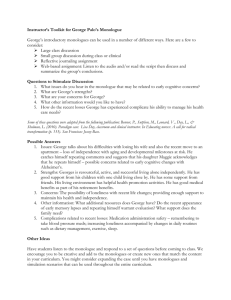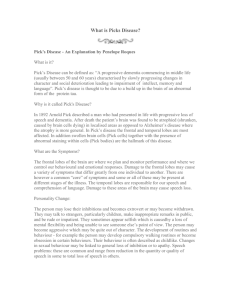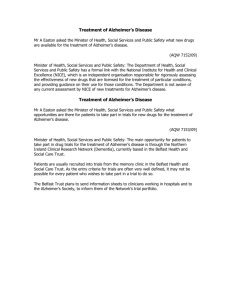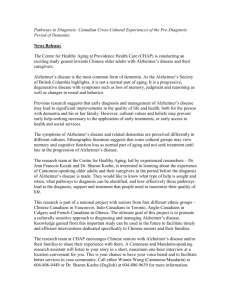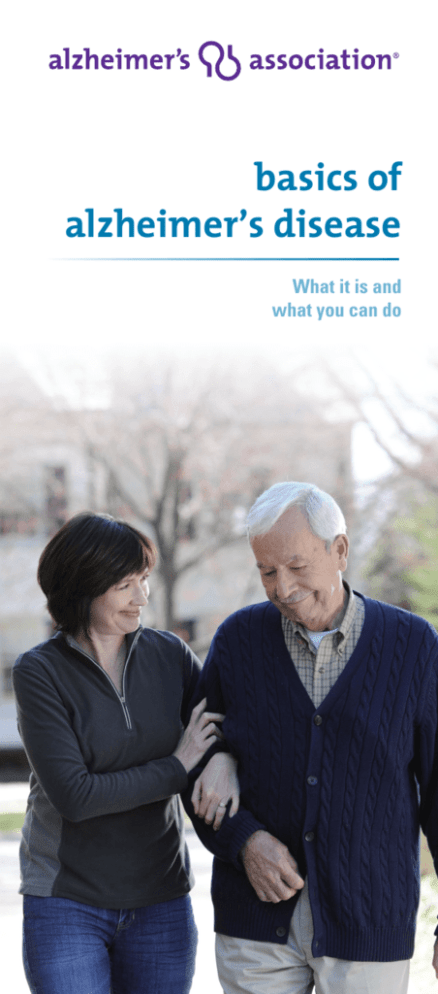
basics of
alzheimer’s disease
What it is and
what you can do
What is Alzheimer’s disease?
Alzheimer’s (AHLZ-high-merz) is a disease of the brain that
causes problems with memory, thinking and behavior. It is
not a normal part of aging.
Alzheimer’s gets worse over time. Although symptoms
can vary widely, the first problem many people notice is
forgetfulness severe enough to affect their ability to function
at home or at work, or to enjoy lifelong hobbies.
The disease may cause a person to become confused,
get lost in familiar places, misplace things or have trouble
with language.
It can be easy to explain away unusual behavior as part
of normal aging, especially for someone who seems
physically healthy. Any concerns about memory loss should
be discussed with a doctor.
1
Basics of Alzheimer’s Disease is a guide for
anyone who would like to learn about the
disease and other dementias.
1 Alzheimer’s disease and other types
of dementia.................................................... p.3
2 How Alzheimer’s affects the brain............... p.5
3 Causes and risk factors................................. p.7
4 How to find out if it’s Alzheimer’s disease... p.9
5 When the diagnosis is Alzheimer’s.............. p.12
6 Stages of the disease.................................... p.14
7 Treating the symptoms.................................. p.18
8 Hope for the future......................................
p.22
2
1. alzheimer’s disease and
other types of dementia
Alzheimer’s disease
More than 5 million Americans have Alzheimer’s disease,
which is the most common form of dementia accounting
for 60 to 80 percent of all cases. That includes 11 percent
of those age 65 and older and one-third of those 85 and
older. The disease also impacts more than 15 million family
members, friends and caregivers.
Dementia
Dementia is a general term for the loss of memory and
other intellectual abilities serious enough to interfere with
daily life.
Other types of dementia
Vascular dementia is a decline in thinking skills caused
by conditions that block or reduce blood flow to the brain,
depriving brain cells of vital oxygen and nutrients. These
changes in thinking skills sometimes occur suddenly
following strokes that block major brain blood vessels. It
is widely considered the second most common cause of
dementia after Alzheimer’s disease.
Mixed dementia is a condition in which abnormalities
characteristic of more than one type of dementia occur
simultaneously. Symptoms may vary, depending on the
types of brain changes involved and the brain regions
affected, and may be similar to or even indistinguishable
from those of Alzheimer’s or another dementia.
Parkinson’s disease dementia is an impairment in
thinking and reasoning that eventually affects many people
with Parkinson’s disease. As brain changes gradually spread,
they often begin to affect mental functions, including
memory and the ability to pay attention, make sound
judgments and plan the steps needed to complete a task.
Dementia with Lewy bodies is a type of progressive
dementia that leads to a decline in thinking, reasoning and
independent function due to abnormal microscopic deposits
that damage brain cells.
3
Huntington’s disease dementia is a progressive brain
disorder caused by a defective gene. It causes changes in
the central area of the brain, which affect movement, mood
and thinking skills.
Creutzfeldt-Jakob disease is the most common human
form of a group of rare, fatal brain disorders known as
prion diseases. Misfolded prion protein destroys brain cells,
resulting in damage that leads to rapid decline in thinking
and reasoning as well as involuntary muscle movements,
confusion, difficulty walking and mood changes.
Frontotemporal dementia (FTD) is a group of disorders
caused by progressive cell degeneration in the brain’s
frontal lobes (the areas behind the forehead) or its temporal
lobes (the regions behind the ears).
Normal pressure hydrocephalus is a brain disorder
in which excess cerebrospinal fluid accumulates in the
brain’s ventricles, causing thinking and reasoning problems,
difficulty walking and loss of bladder control.
Down syndrome dementia develops in people born with
extra genetic material from chromosome 21, one of the 23
human chromosomes. As individuals with Down syndrome
age, they have a greatly increased risk of developing a type
of dementia that’s either the same as or very similar to
Alzheimer’s disease.
Korsakoff syndrome is a chronic memory disorder caused
by severe deficiency of thiamine (vitamin B-1). It is most
commonly caused by alcohol misuse, but certain other
conditions can also cause the syndrome.
Posterior cortical atrophy (PCA) is the gradual and
progressive degeneration of the outer layer of the brain
(the cortex) located in the back of the head (posterior). It is
not known whether PCA is a unique disease or a possible
variant form of Alzheimer’s disease.
4
2. how alzheimer’s
affects the brain
The changes that take place in the brain begin at the
microscopic level long before the first signs of memory loss.
What goes wrong in the brain
The brain has 100 billion nerve cells (neurons). Each nerve
cell connects to many others to form communication
networks. In addition to nerve cells, the brain includes cells
specialized to support and nourish other cells.
Groups of nerve cells have special jobs. Some are involved
in thinking, learning and memory. Others help us see, hear,
smell and tell our muscles when to move.
Brain cells operate like tiny factories. They receive supplies,
generate energy, construct equipment and get rid of waste.
Cells also process and store information and communicate
with other cells. Keeping everything running requires
coordination as well as large amounts of fuel and oxygen.
Scientists believe Alzheimer’s disease prevents parts of a
cell’s factory from running well. They are not sure where
the trouble starts. But just like a real factory, backups and
breakdowns in one system cause problems in other areas.
As damage spreads, cells lose their ability to do their jobs
and, eventually, die.
Take a closer look
Take our Inside the Brain: An Interactive
Tour at alz.org/brain to learn how Alzheimer’s
affects the brain and its functions.
5
The role
of plaques
and tangles
The brains of individuals
with Alzheimer’s have an
abundance of plaques
and tangles. Plaques
are deposits of a protein
fragment called betaamyloid that build up in
the spaces between nerve
cells. Tangles are twisted
fibers of another protein
called tau that build up
inside cells.
How Alzheimer’s
spreads in the brain
Though autopsy studies
show that most people
develop some plaques and
tangles as they age, those
with Alzheimer’s tend to
develop far more. They
also tend to develop them
in a predictable pattern,
beginning in the areas
important for memory
before spreading to
other regions.
Scientists do not know
exactly what role plaques
and tangles play in
Alzheimer’s disease.
Most experts believe
that they disable or block
communication among
nerve cells and disrupt
processes the cells need
to survive.
Illustrations:
Alzheimer’s Disease
Education and Referral Center,
a service of the
National Institute on Aging
The destruction and death of nerve cells causes memory
failure, personality changes, problems in carrying out daily
activities and other symptoms of Alzheimer’s disease.
6
3. causes and risk factors
While scientists know that Alzheimer’s disease involves the
failure of nerve cells, why this happens is still unknown.
However, they have identified certain risk factors that
increase the likelihood of developing Alzheimer’s.
Age
The greatest known risk factor for Alzheimer’s disease
is increasing age. Most individuals with the illness are
65 and older. One in nine people in this age group has
Alzheimer’s. Nearly one-third of people age 85 and older
have Alzheimer’s.
Family history
Another risk factor is family history. Research has shown
that those who have a parent, brother or sister with
Alzheimer’s are more likely to develop the disease than
individuals who do not. The risk increases if more than one
family member has the illness.
Familial Alzheimer’s and genetics
Two categories of genes influence whether a person
develops a disease: risk genes and deterministic genes.
Risk genes increase the likelihood of developing a disease
but do not guarantee it will happen. Deterministic genes
directly cause a disease, guaranteeing that anyone who
inherits one will develop a disorder.
Researchers have found several genes that increase the
risk of Alzheimer’s. APOE-e4 is the first risk gene identified
and remains the one with strongest impact. Other common
forms of the APOE gene are APOE-e2 and APOE-e3.
Everyone inherits a copy of some form of APOE from each
parent. Those who inherit one copy of APOE-e4 have an
increased risk of developing Alzheimer’s; those who inherit
two copies have an even higher risk but not a certainty.
Rare deterministic genes cause Alzheimer’s in a few
hundred extended families worldwide. These genes are
estimated to account for less than 1 percent of cases.
Individuals with these genes usually develop symptoms in
their 40s or 50s.
7
Latinos and African-Americans
Research shows that older Latinos are about one-and-ahalf times as likely as older whites to have Alzheimer’s
and other dementias. Older African-Americans are about
twice as likely to have Alzheimer’s and other dementias
as older whites. The reason for these differences is not
well understood, but researchers believe that higher rates
of vascular disease in these groups may also put them at
greater risk for developing Alzheimer’s.
Other risk factors
Age, family history and genetics are all risk factors we
can’t change. Research is beginning to reveal clues about
other risk factors that we may be able to influence. There
appears to be a strong link between serious head injury
and future risk of Alzheimer’s. It’s important to protect your
head by buckling your seat belt, wearing a helmet when
participating in sports and proofing your home to avoid falls.
One promising line of research suggests that strategies for
overall healthy aging may help keep the brain healthy and
may even reduce the risk of developing Alzheimer’s. These
measures include eating a healthy diet, staying socially
active, avoiding tobacco and excess alcohol, and exercising
both the body and mind.
8
Some of the strongest evidence links brain health to heart
health. The risk of developing Alzheimer’s or vascular
dementia appears to be increased by many conditions that
damage the heart and blood vessels. These include heart
disease, diabetes, stroke, high blood pressure and high
cholesterol. Work with your doctor to monitor your heart
health and treat any problems that arise.
Studies of donated brain tissue provide additional evidence
for the heart-head connection. These studies suggest that
plaques and tangles are more likely to cause Alzheimer’s
symptoms if strokes or damage to the brain’s blood vessels
are also present.
4. how to find out if it’s
alzheimer’s disease
Not everyone experiencing memory loss or other possible
Alzheimer’s warning signs recognizes that they have a
problem. Signs of dementia are sometimes more obvious to
family members or friends.
The first step in following up on symptoms is finding a
doctor with whom a person feels comfortable. There is no
single type of doctor that specializes in diagnosing and
treating memory symptoms or Alzheimer’s disease. Many
people contact their regular primary care physician about
their concerns. Primary care doctors often oversee the
diagnostic process themselves.
In some cases, the doctor may refer the individual to a
specialist such as a:
› N eurologist who specializes in diseases of the brain and
nervous system.
› P sychiatrist who specializes in disorders that affect
mood or the way the mind works.
› P sychologist with special training in testing memory and
other mental functions.
9
There is no single test that proves a person has Alzheimer’s.
The workup is designed to evaluate overall health and
identify any conditions that could affect how well the mind
is working. When other conditions are ruled out, the doctor
can then determine if it is Alzheimer’s or another dementia.
Experts estimate that a skilled physician can diagnose
Alzheimer’s with more than 90 percent accuracy. Physicians
can almost always determine that a person has dementia, but
it may sometimes be difficult to determine the exact cause.
Steps to diagnosis include:
Understanding the problem
Be prepared for the doctor to ask:
›W
hat kind of symptoms have occurred.
›W
hen they began.
› H ow often they happen.
› If they have gotten worse.
Reviewing medical history
The doctor will interview the person being tested and others
close to him or her to gather information about current and
past mental and physical illnesses. It is helpful to bring a
list of all the medications the person is taking. The doctor
will also obtain a history of key medical conditions affecting
other family members, especially whether they may have or
had Alzheimer’s disease or other dementias.
Evaluating mood and mental status
Mental status testing evaluates memory, the ability
to solve simple problems and other thinking skills.
This testing gives an overall sense of whether
a person:
› Is aware of symptoms.
› K nows the date, time and where he or she is.
› C an remember a short list of words, follow instructions
and do simple calculations.
10
The doctor may ask the person his or her address, what year
it is or who is serving as president. The individual may also
be asked to spell a word backward, draw a clock or copy a
design. The doctor will also assess mood and sense of wellbeing to detect depression or other illnesses that can cause
memory loss and confusion.
Physical exam and diagnostic tests
A physician will:
› E valuate diet and nutrition.
› C heck blood pressure, temperature and pulse.
› L isten to the heart and lungs.
› P erform other procedures to assess overall health.
The physician will collect blood and urine samples
and may order other laboratory tests. Information from
these tests can help identify disorders such as anemia,
infection, diabetes, kidney or liver disease, certain vitamin
deficiencies, thyroid abnormalities, and problems with
the heart, blood vessels or lungs. All of these conditions
may cause confused thinking, trouble focusing attention,
memory problems or other symptoms similar to dementia.
Neurological exam
A doctor will closely evaluate the person for problems that
may signal brain disorders other than Alzheimer’s.
The physician will also test:
› R eflexes.
› C oordination.
›M
uscle tone and strength.
› E ye movement.
› S peech.
› S ensation.
The doctor is looking for signs of small or large
strokes, Parkinson’s disease, brain tumors, fluid
accumulation on the brain and other illnesses that
may impair memory or thinking.
11
The neurological exam may also include a brain imaging
study. The most common types are magnetic resonance
imaging (MRI) or computed tomography (CT). MRIs and
CTs can reveal tumors, evidence of small or large strokes,
damage from severe head trauma or a buildup of fluid.
Researchers are studying other imaging techniques so they
can better diagnose and track the progress of Alzheimer’s.
5. when the diagnosis
is alzheimer’s
Once testing is complete, the doctor will make an appointment
to review results and share his or her conclusions. A diagnosis
of Alzheimer’s reflects a doctor’s best judgment about the
cause of a person’s symptoms, based on the testing performed.
You may want to ask the doctor:
›W
hy the diagnosis is Alzheimer’s.
›W
here the person may be in the course of
the disease.
›W
hat to expect in the future.
Find out if the doctor will manage care going forward and,
if not, who will be the primary doctor. The doctor can then
schedule the next appointment or provide a referral.
12
Alzheimer’s disease is life-changing for both the diagnosed
individual and those close to him or her. While there is
currently no cure, treatments are available that may help
relieve some symptoms. Research has shown that taking
full advantage of available treatment, care and support
options can improve quality of life.
Consider:
› H ow to provide increasing levels of care as the
disease progresses.
› H ow the individual and family members will cope
with changes in the person’s ability to drive, cook and
perform other daily activities.
› H ow to ensure a safe environment.
It is also important to begin making legal and financial plans.
A timely diagnosis often allows the person with dementia to
participate in this planning. The person can also decide who
will make medical and financial decisions on his or her behalf in
later stages of the disease.
Create an action plan
To learn more about planning for the future, visit
Alzheimer’s Navigator (alz.org/alzheimersnavigator).
Create a customized action plan that provides information,
support, community resources and more.
®
13
6. stages of the disease
Alzheimer’s disease typically progresses slowly in
three general stages: mild (early), moderate (middle),
and severe (late).
Overview of disease progression
The symptoms of Alzheimer’s worsen over time, but because
the disease affects people in different ways, the rate of
progression varies. On average, a person with Alzheimer’s
lives four to eight years after diagnosis, but can live as long
as 20 years, depending on other factors.
Changes in the brain related to Alzheimer’s begin years before
any signs of the disease. This time period, which can last
years, is referred to as preclinical Alzheimer’s disease.
The following stages provide an overall idea of how abilities
change once symptoms appear and should be used as a
general guide. Stages may overlap, making it difficult to place
a person with Alzheimer’s in a specific stage.
Mild Alzheimer’s Disease (Early-stage)
In the early stage of Alzheimer’s, a person may function
independently. He or she may still drive, work and be part of
social activities. Despite this, the person may feel as if he
or she is having memory lapses, such as forgetting familiar
words or the location of everyday objects.
Friends, family or neighbors begin to notice difficulties.
During a detailed medical interview, doctors may be able
to detect problems in memory or concentration. Common
difficulties include:
› P roblems coming up with the right word or name.
› T rouble remembering names when introduced to
new people.
› H aving greater difficulty performing tasks in social or
work settings.
14
› F orgetting material that was just read.
› L osing or misplacing a valuable object.
› Increasing trouble with planning or organizing.
Moderate Alzheimer’s Disease
(Middle-stage)
Moderate Alzheimer’s is typically the longest stage and can
last for many years. As the disease progresses, the person
with Alzheimer’s will require a greater level of care.
You may notice the person with Alzheimer’s confusing
words, getting frustrated or angry, or acting in unexpected
ways, such as refusing to bathe. Damage to nerve cells
in the brain can make it difficult to express thoughts and
perform routine tasks.
At this point, symptoms will be noticeable to others and
may include:
› F orgetfulness of events or about one’s own
personal history.
› F eeling moody or withdrawn, especially in socially or
mentally challenging situations.
› B eing unable to recall their address or telephone number
or the high school or college from which they graduated.
› C onfusion about where they are or what day it is.
› T he need for help choosing proper clothing for the season
or the occasion.
› T rouble controlling bladder and bowels in
some individuals.
› C hanges in sleep patterns, such as sleeping during the
day and becoming restless at night.
› A n increased risk of wandering and becoming lost.
› P ersonality and behavioral changes, including
suspiciousness and delusions or compulsive, repetitive
behavior like hand wringing or tissue shredding.
15
Severe Alzheimer’s Disease (Late-stage)
In the final stage of this disease, individuals lose the ability to
respond to their environment, to carry on a conversation and,
eventually, to control movement. They may still say words
or phrases, but communicating pain becomes difficult. As
memory and cognitive skills continue to worsen, personality
changes may take place and individuals need extensive help
with daily activities.
At this stage, individuals may:
› R equire full-time, around-the-clock assistance with daily
activities and personal care.
› L ose awareness of recent experiences as well as of
their surroundings.
› E xperience changes in physical abilities, including the
ability to walk, sit and, eventually, swallow.
› H ave increasing difficulty communicating.
› B ecome vulnerable to infections, especially pneumonia.
16
Wandering
Six out of 10 people with Alzheimer’s disease will wander
and become lost. People can wander or become confused
about their location at any stage of the disease. If not
found within 24 hours, up to half of those who get lost risk
serious injury or death.
The Alzheimer’s Association offers services to help ensure
®
®
safety. Medic Alert + Alzheimer’s Association Safe Return is
a 24-hour emergency response service that provides assistance
when a person with dementia becomes lost or has a medical
emergency. Another great service is Alzheimer’s Association
®
Comfort Zone , a comprehensive Web-based location
management system that allows families to monitor a person
with Alzheimer’s.
Visit alz.org/safety to learn more.
17
7. treating the symptoms
Currently, there is no cure for Alzheimer’s and no way to
stop the underlying death of brain cells. But drugs and
non-drug treatments may help with both cognitive and
behavioral symptoms.
A comprehensive care plan for Alzheimer’s disease:
› C onsiders appropriate treatment options.
›M
onitors treatment effectiveness as the
disease progresses.
› C hanges course and explores alternatives as necessary.
› R espects individual and family goals for treatment and
tolerance for risk.
Key terms
Symptoms
Cognitive: Symptoms that affect memory, awareness,
language, judgment and ability to plan, organize and carry
out other thought processes.
Behavioral: A group of additional symptoms that occur to
at least some degree in many individuals with Alzheimer’s.
In early stages, people may experience personality changes
such as irritability, anxiety or depression. In later stages,
individuals may develop sleep disturbances; wandering
impulses; agitation (physical or verbal aggression, general
emotional distress, restlessness, pacing, shredding paper
or tissues, yelling); delusions (firmly held belief in things
that are not real); or hallucinations (seeing, hearing or
feeling things that are not there).
Treatments
FDA-approved: Medication approved by the U.S. Food
and Drug Administration (FDA) that specifically treats a
symptom of Alzheimer’s disease.
Non-drug: A treatment other than medication that helps
relieve symptoms of Alzheimer’s disease.
18
Cognitive symptoms
Three types of drugs are currently approved by the FDA to
treat cognitive symptoms of Alzheimer’s disease.
The first type, cholinesterase (KOH-luh-NES-ter-ays)
inhibitors, prevents the breakdown of acetylcholine (a-SEAtil-KOH-lean), a chemical messenger important for memory
and learning. By keeping levels of acetylcholine high, these
drugs support communication among nerve cells.
Three cholinesterase inhibitors are commonly prescribed:
› D onepezil (Aricept ), approved in 1996 to treat mild-to®
moderate Alzheimer’s and in 2006 for the severe stage.
› R ivastigmine (Exelon ), approved in 2000 for
®
mild-to-moderate Alzheimer’s.
› G alantamine (Razadyne ), approved in 2001 for mild-to®
moderate stages.
The second type of drug works by regulating the activity
of glutamate, a different messenger chemical involved in
information processing:
›M
emantine (Namenda ), approved in 2003 for
®
moderate-to-severe stages, is the only currently
available drug in this class.
The third type is a combination of cholinesterase inhibitor
and a glutamate regulator.
› Donepezil and memantine (Namzaric ), approved in
®
2014 for moderate-to-severe stages.
The effectiveness of the types of treatments varies
from person to person. While they may temporarily help
symptoms, they do not slow or stop the brain changes that
cause Alzheimer’s to become more severe over time.
Behavioral symptoms
Many find behavioral changes like anxiety, agitation,
aggression and sleep disturbances to be the most
challenging and distressing effect of Alzheimer’s disease.
These changes can greatly impact the quality of life for
individuals living in both family situations and long-term
residential care.
19
As with cognitive symptoms of Alzheimer’s, the chief
underlying cause of behavioral and psychiatric symptoms
is the progressive damage to brain cells. Other possible
causes of behavioral symptoms include:
› D rug side effects
Side effects from prescription medications may be at
work. Drug interactions may occur when taking multiple
medications for several conditions.
›M
edical conditions
Symptoms of infection or illness, which may be
treatable, can affect behavior. Pneumonia or urinary
tract infections can bring discomfort. Untreated ear or
sinus infections can cause dizziness and pain.
› Environmental influences
Situations affecting behavior include moving to a
new private residence or residential care facility;
misperceived threats; or fear and fatigue from trying to
make sense of a confusing world.
There are two types of treatments for behavioral symptoms:
non-drug treatments and prescription medications.
20
Non-drug treatments
Steps to developing non-drug treatments include:
› Identifying the symptom.
› U nderstanding its cause.
› C hanging the caregiving environment to remove
challenges or obstacles.
Identifying what has triggered behaviors can often help in
selecting the best approach. Often the trigger is a change
in the person’s environment, such as:
› N ew caregivers.
› D ifferent living arrangements.
› T ravel.
› A dmission to a hospital.
› P resence of houseguests.
› B eing asked to bathe or change clothes.
Because people with Alzheimer’s gradually lose the ability
to communicate, it is important to regularly monitor their
comfort and anticipate their needs.
Prescription medications
Medications can be effective in managing some behavioral
symptoms, but they must be used carefully and are most
effective when combined with non-drug treatments.
Medications should target specific symptoms so that response
to treatment can be monitored.
Prescribing any drug for a person with Alzheimer’s is
medically challenging. Use of drugs for behavioral and
psychiatric symptoms should be closely supervised.
Some medications, called atypical antipsychotics, are
associated with an increased risk of serious side effects. The
benefits and risks of these medications should be carefully
weighed when deciding whether they should be used.
21
8. hope for the future
The Alzheimer’s Association is the world’s largest nonprofit
funder of Alzheimer’s research. Since 1982, we have
awarded over $340 million to more than 2,250 research
investigations worldwide.
When Alois Alzheimer first described the disease in 1906,
a person in the United States lived an average of about 50
years. Few people reached the age of greatest risk. As a
result, the disease was considered rare and attracted little
scientific interest. That attitude changed as the average life
span increased and scientists began to realize how often
Alzheimer’s strikes people in their 70s and 80s. The Centers
for Disease Control and Prevention recently estimated an
average person’s life expectancy to be 78.7 years.
Today, Alzheimer’s is at the forefront of biomedical
research, with 90 percent of what we know discovered in
the last 20 years. Some of the most remarkable progress
has shed light on how Alzheimer’s affects the brain. Better
understanding of its impact may lead to better treatments.
22
Clinical studies drive progress
Scientists are constantly working to advance research.
But without clinical research and the help of human
volunteers, we cannot treat, prevent or cure Alzheimer’s.
Clinical trials test new interventions or drugs to prevent,
detect or treat disease for safety and effectiveness. Clinical
studies are any type of clinical research involving people.
Clinical studies can also look at other aspects of care, such
as improving quality of life. Every clinical trial or study
contributes valuable knowledge, regardless if favorable
results are achieved.
Visit alz.org/TrialMatch to learn more about Alzheimer’s
Association TrialMatch®, a clinical studies matching
service that connects individuals living with Alzheimer’s,
caregivers, healthy volunteers and physicians with current
Alzheimer’s-related clinical studies.
23
New directions in treatment
and prevention
One promising target is beta-amyloid. This protein fragment
builds up into the plaques considered one hallmark of the
disease. Researchers have developed several ways to clear
beta-amyloid from the brain or prevent it from clumping
together into plaques. Experimental drugs that zero in on
beta-amyloid are now being tested.
Many other new approaches to treatment are also under
investigation worldwide. We don’t yet know which of
these strategies may work, but scientists say that with
the necessary funding, the outlook is good for developing
treatments that slow or stop Alzheimer’s.
While there is no known way to prevent Alzheimer’s
disease, emerging research suggests that the steps
people take to maintain heart health may also reduce
the risk of Alzheimer’s.
This connection makes sense, because the brain is
nourished by one of the body’s richest networks of blood
vessels, and the heart is responsible for pumping blood
through these blood vessels to the brain. It’s especially
important for people to do everything they can to keep
weight, blood pressure, cholesterol and blood sugar within
recommended ranges to reduce the risk of heart disease,
stroke and diabetes. Eating a low-fat diet rich in fruits and
vegetables, exercising regularly, and staying mentally
and socially active may all help protect the brain.
24
24/7 Helpline and alz.org
®
The Alzheimer’s Association 24/7 Helpline (800.272.3900)
provides free, reliable information and support to all those
who need assistance — people with dementia, caregivers,
health care professionals and the public.
Our 24/7 Helpline features:
› C onfidential care consultation provided by master’s-level
clinicians who can help with decision-making support,
crisis assistance and education on issues families face
every day.
› H elp in a caller’s preferred language through our
translation service, which accomodates more than
200 languages.
› R eferrals to local community programs, services and
ongoing support.
Our award-winning website at alz.org is a rich resource
that helps inform and educate multiple audiences, including
those with the disease, caregivers and professional health
care providers. Alz.org features:
› A lzheimer’s and Dementia Caregiver Center
(alz.org/care) for all those who care for a person with
Alzheimer’s disease or another dementia.
› I Have Alzheimer’s (alz.org/IHaveAlz) for those living in
the early stage of the disease.
25
We’re here for you all day, every day.
800.272.3900 | alz.org
®
26
alz.org
®
Access reliable information and resources, such as:
› A lzheimer’s Navigator
— Assess your needs and
create customized action plans.
®
› Community Resource Finder — Find local resources.
› A LZConnected — Connect with other caregivers
®
or persons with dementia.
› Alzheimer’s and Dementia Caregiver Center —
Get information for all stages of the disease.
› Safety Center — Access information and tools.
alz.org/training
Free online workshops, including:
› The Basics: Memory Loss, Dementia and
Alzheimer’s Disease
alz.org/findus
Support groups, education programs and more
available in communities nationwide.
800.272.3900
24/7 Helpline — Available all day, every day.
The Alzheimer’s Association is the world’s leading
voluntary health organization in Alzheimer’s care,
support and research. Our mission is to eliminate
Alzheimer’s disease through the advancement of
research; to provide and enhance care and support
for all affected; and to reduce the risk of dementia
through the promotion of brain health.
Our vision is a world without Alzheimer’s .
®
800.272.3900 | alz.org
®
This is an official publication of the Alzheimer’s Association but may be distributed by unaffiliated
organizations and individuals. Such distribution does not constitute an endorsement of these
parties or their activities by the Alzheimer’s Association.
© 2015 Alzheimer’s Association ® . All rights reserved.
27
SHOP-15-144
770-10-0003


